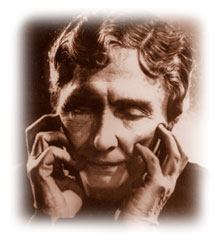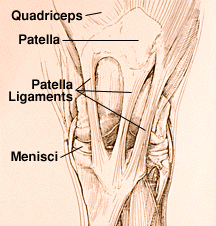 ˝ When one door closes, another opens. But we often look so regretfully upon the closed door that we don't see the one that has opened for us. ˝ - Helen Adams Keller |
Love Conquers Everything, Children of Europe for Unicef
 ˝ When one door closes, another opens. But we often look so regretfully upon the closed door that we don't see the one that has opened for us. ˝ - Helen Adams Keller |
Love Conquers Everything, Children of Europe for Unicef
The Problem with StiflingA common complaint you will hear from savvy riders is that their horse is stifled. You can sympathize with them if you have had a horse with stifle problems and if not then you likely do not know what they are talking about. | |
|
A horse’s stifle can be pointed out by all horsemen, but no matter how experienced a rider is they don’t know much about the inner working of the stifle. The stifle can be difficult to evaluate due to its size and location. In combination with a lack of understanding regarding its structure and function the topic of the stifle becomes almost as much of a myth among horsemen as medicine. | |
types of injuries associated with it. Confusion is often found when using the term “knee” since a horse has four legs. The stifle is the true “knee” of a horse and is found only on the hind limbs of the horse. The forelimb of the horse is comparable to the human arm so the “knee” of these limbs is structurally similar to our wrist. More properly it should be called the carpas.  Two individual joints make up the stifle and it is determined by the bones that join together there. The femoral-tibal joint is used to communicated between the large bone in the upper leg called the femur and the smaller bone below it called the tibia. Communication from the patella or kneecap is sent to the femur through the femoral-patella joint. The stifle is made up of these two joints. A thin capsule surrounds the entire stifle joint that has a specialized fluid to help with shock absorption and lubrication. |
말을 뱉으면, 혹은 글을 쓰게 되면 -- 어쨌든 같은 얘기지만, 그 순간 나를 구속한다. 아니, 말이 상대의 귀를 통해 혹은 글이 상대의 눈을 통해 사고 과정을 거쳐 어떤 인식으로 자리잡는 순간 나를 구속한다. 아니, 상대가 인식으로 자리잡았다고 내가 인식하거나 인식으로 자리잡을 것을 예상함을 내가 인식하는 순간 나는 내 말과 글에 구속된다. 결국 내 인식이 나를 구속한다. (물론 전혀 구속되지 않는 자유로운 이성을 가진 이도 많다.) 그리고는 후회한다. 괜히 말해서 일을 벌렸어... 괜히 글을 써놓고는 어떤 반론이 올라올까 전전긍긍이네... 등 등, 애초에 말을 뱉지 않거나 글을 쓰지 않았다면 아무 일도 일어나지 않았을 것이라고 후회한다. 그러면서도 방관자는 되기 싫으니까, 꼭 그 짓을 또 하고야 만다. 그리고 또 후회한다. 결국은 상대방의 반응이 없을 떄까지, 혹은 내가 감내할 수 있는 범위내에서(상대방의 말과 글에 대한 내 이성의 반응역치 내에서) 일을 정리한다. 그 순간 나는 해방되고, 그 동안의 시간, 그 시간 동안의 정신적 사고 및 육체적 노력은 사라진다. 말하자면, 말을 뱉거나 글을 쓰는 이전으로 상황은 돌아가고 그 사이 생산물들은 결실을 못보고 사라지는 것이다. 나는 그저 내 이성의 범위와 한계를 다시 한번 확인했을 뿐인 것이다. 삶도 이와 같다. 태어나는 순간 나를 구속한다. 내가 살아있고, 인격을 존중 받아야 할 존재라는 것을 인식하는 순간 나를 구속한다. 내가 죽을 지경에 처함을 인식하거나 인격이 비하된다고 인식할 때, 또는 그럴 것이라고 예상함을 내가 인식하는 순간 나는 반응한다. 결국 내 삶이 나를 구속한다. 내 삶을 내가 인식할 때 나는 구속된다. 데카르트는 나는 생각한다 고로 존재한다고 했는데, 데카르트는 결국 생각함으로써 존재에 구속되었다. 데카르트가 생각하지 않으면 인식하지 못하고 인식하지 못하면 존재하지 않는다. 그 순간 데카르트는 해방되고 존재 이전의 상황으로 돌아간다. 데카르트는 그저 이성의 범위와 한계를 테스트했을 뿐이다.
삼일절이다. 1919년 삼일운동이 없었다면 현재의 상황은 달랐을 지도 모른다. 삼일운동 참가자는 후회하지 않기 위해 시행한것이고 나는 후회하지 않기 위해 시행하지 않는다. 삼일운동참가자는 당시의 상황을 바꾸기 위해 시행한 것이고 나는 현재의 상황이 바뀜을 원치 않기에 시행하지 않는 것이다. 아니, 삼일운동 참가자는 한편으로는 후회할 지도 모르지만 당장은 후회하지 않기에 시행한 것이다. 나도 당장은 후회하지 않기 위해 일을 저지르고는 바로 후회한다. 후회하지 않기 위해 시행하고 시행 후에 후회한다. 후회할 걸 뻔히 알고 시행하는 저의에는 상당한 대의명분이 있다. 지금 이 일을 하지 않으면 안 된다는 그 어떤 대의명분 혹은 절박함 혹은 자존심. 그걸 느끼는 순간 구속된다. 결국 문제는 그것이 결실을 보느냐의 여부다. 시행 후에 후회한다. 시행 후에 반응이 없고, 내가 어느 정도 선에서 끝낸다면 곧 시행이전으로 돌아가고 -- 결실을 보지 못한다. 아무 것도 변하지 않는다. 후회하고 아무 것도 변하지 않는다. 후회하고 아무 것도 변하지 않는 것과 후회하지 않고 아무 것도 변하지 않는 것. 파스칼은 신을 믿을 것인가를 고민하다가 결국 신이 없다면 믿어서 손해볼 건 없지만 신이 있는데 믿지 않는다면 죽어서 손해보므로 믿는 게 낫다 싶어 신의 존재를 믿기 시작했다는데. 그렇다면 후회하지 않고 아무 것도 변하지 않는 게 더 나은가? 그러나, 후회는 무조건 발생한다. 이렇게 쓰기 시작한 걸 후회하고 있다. 이만큼 썼기에, 시간을 들였기에 버리기 아깝다. 이 글에 구속된다. 윗단락에 상황 이전으로 돌아가면 모든 생산물이 사라진다고 했지만 사라지는 것이 아니라 인식 저편으로 미뤄놓는 것 뿐이다. 결국, 아무 것도 사라지지 않는다. 아무 것도 사라지지 않는다는 사실이 모든 구속의 근본이다. 내가 한 일, 말, 글 등이 사라지지 않기에 후회하고 구속된다. 그리하여 늙은이들은 죽을 때가 되면 인식 저편에 미뤄놓은 것들을 생각한다. 이를 추억이라 부른다. 죽기 전에 사라지지 않는 것들을 불러내어 스스로 구속되고자 하는 것이다. 구속되기에 사람은 존재하는 것이므로... 존재하기에 후회하는 것이다. 결국 인간은 평생 후회할 수 밖에 없다. 사라지는 것들은 후회하지 않는다... 머리가 병신이라 생각이 사라진 이들도 후회하지 않는다... 그래서 정신이 병신인 인간은 적어도 스물 다섯 단계는 정상인보다 상위 클래스에 속한다. 이런 의미에서, 불교의 대선사들은 모두 병신들이다.